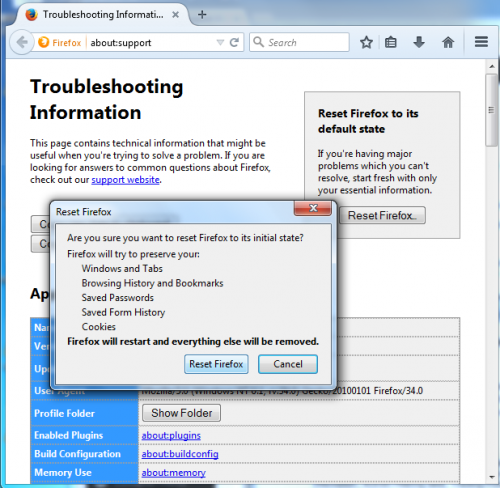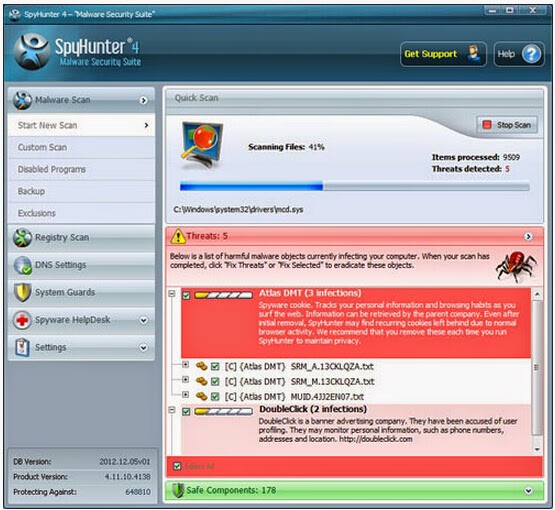It is Annoying to be with HTTP Fake AV Redirect Request
HTTP Fake AV Redirect Request is rampant once again and has been reported to frustrate numerous computer users recently. This thing with skills to arouse unstoppable intrusive and pose a serious security threat is detected by Norton Internet Security and Avast antivirus in a high frequency.
Receiving warning alert reporting this attack means that your computer has been invaded by something malicious and you should pay high attention to system security. And take immediate action to stop any or further damage from happening when necessary.
HTTP Fake AV Redirect Request web attack has much to do with bad things. This signature indicates that a fake antivirus scan page that displays false virus scan results has been detected. You are gonna prevent access to sites that redirect webpage or commit evil conducts to trick you into downloading misleading / rogue programs.

.png)
Why Does HTTP Fake AV Redirect Request Deserve to be Dead?
1) You may be redirected to unwanted sites with the occurrence of such alert.
2) You may also receive random tabs/windows opening up automatically.
3) Your antivirus may squeak frequently, reporting PUP or trojan horse alert.
4) Multiple suspicious processes run in task manager out of control.
5) Some unidentified applications appears on your Programs list suddenly.
Sometimes "HTTP Fake AV Redirect Request" reports a false positive and some cleaning website may be considered as malicious. However, precaution is always better than cure. Whenever receiving such web attack alert, you should be attentive and check for malware speedily.
What Are the Plans to Get Rid of HTTP Fake AV Redirect Request?
Whether HTTP Fake AV Redirect Request is the initiator of the evil or it is maliciously used by cyber hackers, you are advised to act at once and it removed timely because you can't make sure that it won't bring in other computer threats.
Plan A: Eradicate HTTP Fake AV Redirect Request Manually
- Remove intrusive related program from Control Panel
- Reset your browsers one by one
- Delete corrupt files and associated entries
Plan B: Purge HTTP Fake AV Redirect Request Automatically with Anti-malware SpyHunter
- Download and install malware scanner SpyHunter
- Launch the tool and run a scan for "HTTP Fake AV Redirect" related stuff
- Automate the removal and fix the threat with ease
How to Eliminate HTTP Fake AV Redirect Request Manually?
Step 1: End devious processes generated by suspicious program such as a hijacker/adware
Press Win key and "R" key together and you will get the Run box. Type "taskmgr"and hit Enter key. Navigate to Processes tab and find out PUP related processes, end them all.


Start > Control Panel > Programs - Uninstall a program > Suspicious Program> Uninstall

Step 3: Reset your browsers one by one
Internet Explorer:
a) Select the following options one by one: Tool ->> Internet Options ->> Advanced ->> Reset
b) On Reset IE settings tab, tick Delete personal settings, click Reset button and you will get Reset IE Settings window

Mozilla FireFox:
a) Click on the orange Firefox icon->> choose Help ->>choose Troubleshooting information
b) Click on Reset Firefox. Choose Reset Firefox again to make sure that you want to reset the browser to its initial state. Click Finish button when you get the Import Complete window.

Chrome:
Click the Chrome menu on the browser toolbar and select Settings:
a) Scroll down the bottom of the webpage and click on Show Advanced Settings;
b) Scroll down to the bottom once again and click on Reset Settings to restore your chrome to default.

%UsersProfile%\ApplicationData\temp\Suspicious Program C:\Program Files (x86)\WAN Miniport IKEv2\AgileVpn.exe C:\users\user\appdata\local\random.exeStep 5: Erase malware relevant entries
Press Win key and "R" key together and you will get the Run box. Type regedit in the Run box and hit Enter key to open Registry Editor, find out related entries and remove.


HKEY_CURRENT_USER\Software\Microsoft\Internet Explorer\TabbedBrowsing "NewTabPageShow" = "1" HKEY_CURRENT_USER\Software\Microsoft\Internet Explorer\Main "Start Page" = " HKEY_LOCAL_MACHINE\SOFTWARE\Software HKEY_LOCAL_MACHINE\SYSTEM\CurrentControlSet\Services\Wpm HKEY_CURRENT_USER\Software\Microsoft\Windows\CurrentVersion\“[RANDOM CHARACTRERISTIC]”
(If you are a computer noob and want to remove “HTTP Fake AV Redirect Request” with an easy way, you could download the best removal tool - SpyHunter to fix the frustrating issue. SpyHunter, the most popular real-time anti-spyware application designed to assist the average computer user in protecting their PC from various PC threats will be greatly helpful.)
How to Purge HTTP Fake AV Redirect Request Automatically with Anti-malware SpyHunter?
Step 1: Click the icon below to download HTTP Fake AV Redirect Website Redirect fixer SpyHunter



Step 3: Run SpyHunter to scan for this browser hijacker
Click "Start New Scan" button to scan your computer

Step 4: Finally, automate the removal process and get rid of all detected items by clicking "Fix Threats" button

Friendly Recommendations:
1) Anything triggering security alert like HTTP Fake AV Redirect Request should be killed without any hesitation. If the manual solution is kind of complicated for you, you could feel at ease to run a scan for this fake AV Redirect intrusive with SpyHunter.
2) The suggested scanner is good at malware detection. If you need to purge the threat and clean up your PC automatically after it detects the target, you could consider to activate its automatic removal function immediately.


No comments:
Post a Comment
Note: Only a member of this blog may post a comment.